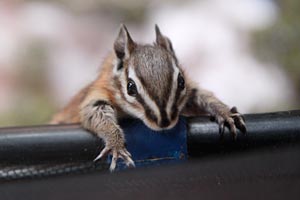The cure for baldness

A worker at Bryce National Park, 70 miles or so north of Best Friends, found the chipmunk and his sibling alongside a trail. Neither was moving. So he collected the two and took them home. Unfortunately, the sibling died before he could get both of them to Wild Friends, the wildlife rehabilitation center at Best Friends.
 |
The chipmunk’s eyes were closed, but he was still breathing, albeit laboriously, when he arrived at Wild Friends the next day. He was also extremely lethargic, underweight and dehydrated. Best Friends wildlife rehabilitators Carmen Smith and Barbara Weider kept him inside an incubator so he could stay warm and get plenty of oxygen. They slowly increased his hydration level before feeding him. Even inside the incubator, he was having trouble maintaining a healthy body temperature. His equilibrium was off, as well. He was having a hard time even standing. Weider and Smith suspected coccidia, a type of parasite that infects the intestinal tracts of animals.
After a few days, his breathing improved, but, unable to use his back legs, his equilibrium did not. He also hadn’t put on any weight. To add insult to injury, his fur started to fall off. That’s when Smith and Weider realized that coccidia wasn’t the only thing he was suffering from.
"Over the next two days, the fur loss increased dramatically, until he only had fur left on his head and feet," Weider says. "We have never seen fur loss in our rehab rodents before, so we contacted a wildlife rehabilitator who is the leading expert in squirrel rehabilitation in the U.S., and she told us that his pattern of loss is the typical presentation of mange in rodents."
Weider and Smith quickly got him on a three-week mange treatment, along with the coccidia treatment. Near the end of the three weeks, the chipmunk started coming around. He was gaining weight and his equilibrium was fine. He was spry even, moving as any healthy chipmunk should. But he was, as Weider says, "still bald as a billiard ball."
A few days after the mange treatment was over, the chipmunk started growing some peach fuzz on his shoulders and later on other parts of his body. Slowly but surely, that peach fuzz turned to actual fur.
"Once his fur came in completely we noticed that he had the most beautiful fur we have ever seen on a chipmunk – silky, long, thick, with very vibrant markings," Weider says.
The chipmunk was recently released, and one bald Best Friends writer is now wondering if mange treatment may be the ticket back to his former glory days.
By Best Friends staff
Photos by Sarah Ause
Watch a video of Wild Friends.